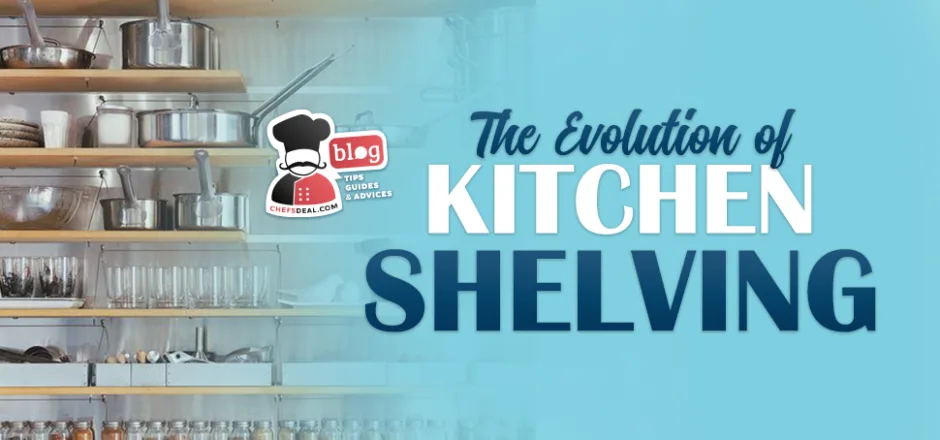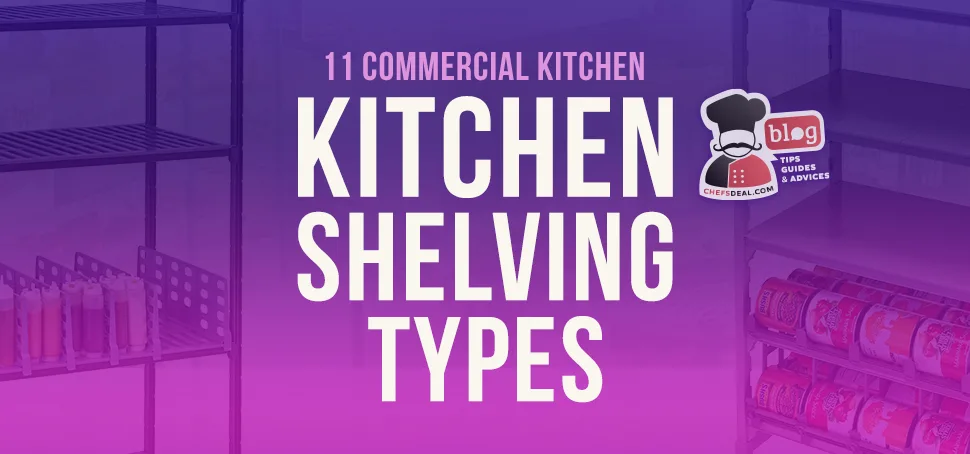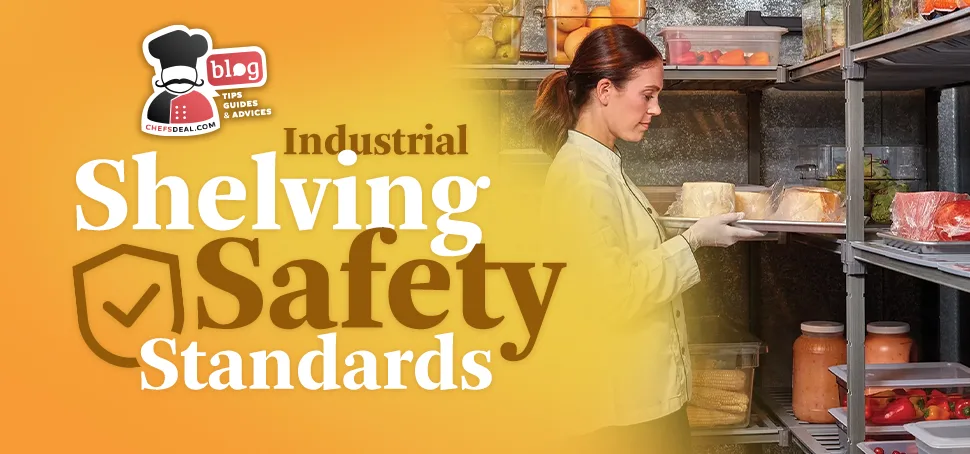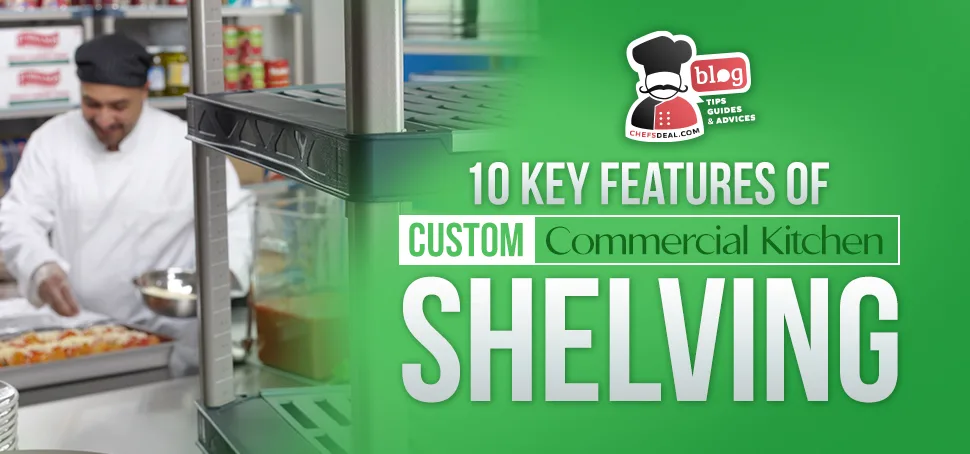Commercial kitchen shelving has evolved significantly from simple, ancient storage solutions to today’s advanced, technology-integrated systems. This overview traces the transformation of shelving through historical designs, material advancements, and the shift toward functionality, smart storage, and sustainability.
We explore how early shelving met basic needs, the impact of material science on durability and design, and the advent of smart shelving systems that enhance operational efficiency. In this article, the focus also extends to sustainability and innovative materials, highlighting their role in modernizing kitchen environments. We reveal the pivotal role of shelving in optimizing commercial kitchen operations, underscoring trends that blend tradition with cutting-edge technology for improved functionality and sustainability.
The Dawn of Shelving Evolution
Shelving has always been a fundamental component in organizing spaces, whether in kitchens, homes, marketplaces, or temples. The requirement of storing and organizing items has taken its roots in old times, leading to the invention of shelving.
The evolution of shelving dates to the earliest human settlements, where basic and primitive kinds of shelving are used, most likely for storing food, tools, and other items. Developments in architecture, craftsmanship, and woodworking advanced shelving systems throughout the time. They have grown from basic storage places to complex fixtures in response to changing lifestyles, technological advancements, and design trends.
Understanding the early development of shelving provides insight into modern design and functionality, bridging the gap between past and present storage solutions.
Historical Shelving Designs
It is hard to say the exact origins of shelves in history. Still, according to written documents and architectural history, contemporary shelves were built in Christian churches during the medieval era. The clergy used a bookcase-like shelving system called ambry to store religious texts. Through time, shelving systems have evolved concerning changing storage requirements, technological investments, and design trends.
In the Middle Ages, shelving is, in its simplest form, hand-made from wood. It is durable and functional, with a minimalistic design, and used as kitchen shelving, bookcases, and storage for tools and items. Later, metal fittings provide an extra layer of protection against deterioration and insects. At this time, decorative concerns are minimal, but functionality is a primary concern.
The effects of art are seen in shelving systems as in every phase of life in the Renaissance. Carvings and hand-painted motifs take place in the design of shelves. Wood and walnut are used, and glass-front cabinets appear at that time, combining practicality and aesthetics.
With the advent of the Industrial Revolution, mass production takes its place in shelving manufacturing. Mass production of shelving systems from factories makes them more accessible and affordable. The materials used in this era are steel, aluminum, and laminates. Freestanding cabinets also emerge at this time.
In the 20th century, the postwar era introduced modular kitchens and specialty shelving systems. The influence of the arts and crafts movement emphasizes craftsmanship, functionality, and simplicity. The beginning of modernism shifted traditional designs to unconventional materials, and open shelving was one of the popular shelving options of the time.
With the development of science and technology, commercial kitchen shelving systems have brought forth a new era. Smart shelving systems and sustainable options became part of the kitchen shelving with features like integrated lights, touchless opening mechanisms, and smart compartments with adjustable temperature options. Sustainability is another invention, looking for recycled materials, energy-efficient manufacturing, and eco-friendly products. Modern commercial kitchen shelving adopts customization and modularity with personalized solutions.
Material Science Developments on Kitchen Shelving
Wood, metal, glass, and plastic are the 4 main kitchen shelving materials that have been used since the beginning but have changed with the development of technology and kitchen storage requirements. Early kitchen shelving made of natural wood or metal was prone to moisture and wear over time. Yet, the advancements in material science provided more durable materials such as stainless steel and engineered wood. Material science developments on kitchen shelving produced more sturdy, durable, corrosion and moisture-resistant materials, and they continue to evolve. The reinforced structure and anti-corrosion coatings took the durability of shelving one step ahead.
- Wood: One of the earliest materials used in kitchen shelving was wood. Early kitchen shelves are often built from wood because of their availability and easy-shaping structure. The durability of sturdy wood boards made them an ideal option for storage solutions.
The basic wood shelves evolved in time with decorative touches like carving, combining decoration with functionality. Wood is still a top material used in kitchen shelving because of its durability, natural look, and adaptability. MDF (medium-density fiberboard) and plywood are later innovated versions of wood, which are popular because they are more affordable and sturdy. MDF is made of multiple wood fibers glued together, and plywood is made from a special sort of manufactured wood panel.
- Metal: Metal, including shelving, has been around the kitchen for ages. Wrought iron and cast iron were the favorites in shelving, with intricate designs and details. With the Industrial Revolution, mass production took place, and aluminum and steel began to be used in shelving construction. Stainless steel has been a popular choice since then due to its durability and corrosion resistance. Stainless steel kitchen shelving is still at the top, providing a sleek appearance, easy cleaning, and hygienic storage. Aluminum shelving is preferred because it is lightweight, making it easy to move.
- Glass: Glass has been used in kitchen shelving from old times, serving as a display shelf or glass-fronted cabinets. Glass was hand-blown in the early times, making it a costly choice for kitchen shelving. The development of modern glass-making techniques has made glass shelving more affordable and available for everyone. Today, tempered glass is preferred in kitchen shelving for its strength and safety. Glass kitchen shelving provides a modern look, display, and easy cleaning.
- Plastic: Plastic is a recent material used in kitchen shelving. Bakelite was the primary form of plastic, invented in the early 20th century, but not widely used. Polyethylene (HDPE) and acrylic are more advanced plastic materials that emerged with the development of polymer science and are used more frequently in kitchen shelving. Plastic is a popular kitchen shelving material due to its versatility, affordability, resistance to moisture, and lightweightness.

What are The Functionality and Design Advancements of Kitchen Shelving
The evolution of kitchen shelving has taken it from a simple storage solution to advanced designs that blend functionality with aesthetics. Kitchen shelving systems evolved to meet the changing lifestyles, storage requirements, technological advancements, and design trends. Modern shelving solutions contribute to efficiency and innovation in industrial kitchens. Here is how the kitchen shelving evolved in terms of design and functionality:
Functionality Improvements on Kitchen Shelving
In early times, shelving systems emerged to meet storage needs, beginning with simple wood plank shelving used to store everything. By that time, with the changing storage needs, cooking habits, and technological innovations, the functionality of kitchen shelving had evolved and improved.
Before, they had limited storage space and consisted of open shelving or simple cabinets in the shape of pantries. Innovative storage solutions with practical features are designed to increase functionality, making use of every available inch with adjustable shelves, corner shelving, modular cabinets, and pull-out pantries to accommodate different kitchen necessities and maximize storage space.
Early kitchen shelving systems were mostly stable, mounted on walls or hung from ceilings. The pull-out drawers, rotating carousels, and adjustable shelving heights improved the accessibility of items, also enhancing the ergonomic workspace.
With the growing number of tools and equipment used in kitchens and the expanding size of the kitchens, establishing an organized working environment become harder. As a functional improvement, the innovation of specialized tools and shelf designs enhances a more organized kitchen.
Customization is one of the functional improvements on kitchen shelving to meet personal preferences and needs. Customizable shelving allows for designing the kitchen in innovative ways, reflecting personal design tastes and maximizing space and efficiency.
Design Evolution of Kitchen Shelving
Kitchen shelving shifted from simple, utilitarian designs that value practicality over aesthetics to decorative designs complementing the style of kitchens. Kitchen shelving has gone through everchanging designs, cultural motifs, and architectural trends ever since.
The importance of ergonomics in kitchen shelving design has increased over time. Ergonomics is all about prioritizing users’ comfort, safety, and efficiency of performance when designing kitchen shelving. It aims to reduce physical strain and risk of health issues and provide easy use and accessibility, enhancing user performance.
Modular shelving design is both a functional and decorative option in kitchen shelving. Modular shelf systems offer customization of shelf types, sizes, construction, shapes, and designs based on storage demands, available space, and aesthetic preferences.
Open shelving is one of the earliest types, still protecting its popularity in kitchens. Open shelving design is versatile, providing storage, display of tools, equipment, or decorative elements, and enhancing accessibility. It also provides customization with variations like floating shelves, ceiling-mounted shelves, or doorless cabinets, which can be adapted to any kitchen layout.
What are The Smart Kitchen Shelving and Storage Systems?
Smart kitchen shelving and storage systems are technology integrated with digital features such as electronic sensors, automated mechanisms, and wireless connections for remote control to improve kitchen organization, efficiency, and convenience. Smart shelving systems use technologies such as automation, real-time data monitoring of inventory, and connectivity with smart home devices, offering users a highly personalized and efficient approach to kitchen organization. This shift from traditional to digital and smart solutions in kitchen shelving marks a transformative evolution in kitchen organization, significantly enhancing functionality by integrating technology.
Smart Shelving Systems
Kitchen shelving offers smart solutions with innovative features as technology takes over every phase of life, providing more than just storage space.
Smart shelving systems with modern technologies integrate with other kitchen and restaurant appliances through IoT, providing a more convenient, innovative, and user-friendly kitchen. IoT is the network of “things,” which are devices and smart equipment utilizing sensors and software to connect and exchange data using the internet. These sensors provide real-time data about inventory levels, humidity, and temperature.
Smart kitchen shelving can be connected to other IoT devices, such as voice assistants, mobile devices, or thermostats, to operate the cabinets and appliances remotely while also providing real-time data, making it easy to keep track of kitchen operations. Voice instructions provide a hands-free process by checking inventory levels, activating lighting or getting cooking recommendations, and facilitating operations.
Smart Storage Features
Smart storage features like automated inventory tracking using IoT enable monitoring of real-time inventory levels. The sensors detect the amount of items on the shelves and automatically update inventory levels. This data can be tracked from your POS system by integrating it with your inventory management software or mobile apps. This provides important information, such as products running short on stock, to help plan orders and menu items.
Automated inventory tracking provides automated reordering based on user preferences and predetermined lists. This software will tell you when a product is running short or reaches a specified reorder point, and you can even reorder it, preventing shortages and streamlining operations.
Another smart storage feature is barcode scanning to identify and track products. Using a scanner app on a mobile phone, which is integrated with the inventory management program, scanning product barcodes provides essential data such as the expiration dates and current inventory.
Led lighting systems enhance visibility and display on shelving by turning on automatically with sensors or opening cabinet doors. Some systems have configurable lighting choices, allowing them to adjust brightness and color temperature depending on preferences.
Smart shelving systems featuring built-in humidity sensors allow for monitoring cabinets’ temperature and humidity levels, helping maintain proper levels, ensuring food safety, and reducing waste.
What are Sustainability and Modern Material Innovations in Shelving?
Sustainability and modern material innovations in foodservice business shelving use recycled and sustainable materials in shelving construction, modular shelving systems, and energy-efficient manufacturing processes to help create an environmentally friendly operation, enhance sustainability, and reduce waste and pollution. Here are the sustainability and modern material innovations in shelving:
Environmental Sustainability Trends
In an age of environmental awareness, sustainability has become a lifestyle in kitchens, too. Kitchen shelving systems have a considerable environmental impact. The shift towards eco-friendly shelving solutions aims to reduce this footprint and enhance sustainable workspaces.
Using recycled materials for kitchen shelving is one of the sustainable practices. Using reclaimed wood, bamboo, recycled glass, metal, and plastic provides a sleek appearance and contributes to waste reduction. Using responsibly sourced materials reduces the need for virgin resources, reducing deforestation.
Using smart shelving systems and features such as smart temperature sensors and automated lighting systems ensures energy efficiency as a sustainable practice. Inventory tracking systems enhance waste management by producing data, analyzing usage patterns, and recommending energy-efficient organization strategies to minimize waste and promote sustainability.
The energy-efficient manufacturing process of kitchen shelving aims to reduce carbon emissions, energy consumption, and environmental contamination by utilizing renewable energy sources, energy-efficient machinery, and sustainable materials.
Innovative Materials in Shelving
Here are the latest material innovations in shelving construction:
Bamboo has recently become a popular kitchen shelving material. This sustainable alternative to conventional hardwood is a fast-growing, extremely durable, and lightweight material, ideal for kitchen shelving construction. Bamboo is also resilient to pests, providing safe storage for food items.
Cork is another popular material that is also sustainable. Cork is harvested from the bark of cork oak trees without damaging the tree. Being fire and water-resistant makes it a great choice for kitchen shelving.
Reclaimed wood is an eco-friendly material used commonly in kitchen shelving. It is rescued from old structures and buildings and turned into kitchen shelving. Reclaimed wood reduces the kitchen’s environmental impact and also provides a modern look.
Composite materials such as engineered wood (MDF) or particleboards are flexible and cost-effective alternatives to traditional wood shelving. They are durable and moisture-resistant, making a great kitchen shelving material.
Carbon fiber is a lightweight yet strong material constructed of carbon atoms bound together. Carbon fiber shelving has a high strength-to-weight ratio, outstanding durability, a sleek, modern design, and a high weight capacity, making it a highly efficient material.
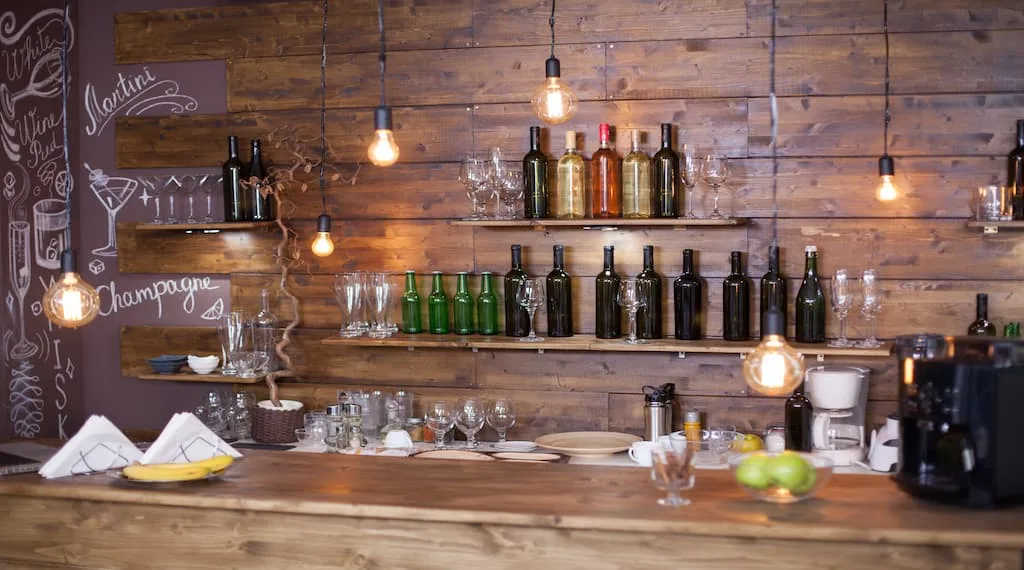
What are Commercial Kitchen Design Trends?
Commercial kitchen design trends are continually changing to meet the changing demands of the industry, integrate innovative technologies for better efficiency, and embrace the smart kitchen idea, which is the future of kitchens. With the evolution of shelving, kitchens adopted both functional and decorative designs, enhancing the overall performance and ambiance of the kitchen. Technological advancements, sustainability concerns, and ergonomic and modular improvements shaped the new trends in commercial kitchen design.
- Integration of Technology: Commercial kitchens practice technological investments more every day. From smart shelving systems to inventory management systems using IoT, technology provides increased efficiency, modern design, and streamlined operations in commercial kitchens.
- Sustainability: Sustainability is becoming one of the primary concerns of commercial kitchens, influencing kitchen designs. Opting for sustainable materials in the construction of kitchen shelving, repurposing old items as decorative or functional kitchen tools, and using energy-efficient appliances and renewable energy sources lowers the environmental footprint of commercial kitchens.
- Automation: Advances in automation provide practicality and efficiency in kitchen design. Integrated sensors in shelving, such as automated lighting, temperature, and humidity sensors, are used to create a proper work environment. Automation in kitchen appliances offers remote control and reduces the effort and time for tasks.
- Modular Design: Modularity in kitchen design offers customization and adaptability to meet changing demands and different decorative preferences and maximize storage space, merging functionality and style.
- Ergonomic Design: The importance of ergonomics is appreciated more with undeniable benefits. Ergonomic design in commercial kitchens improves the comfort and efficiency of staff, minimizing physical strain and reducing health risks. User-friendly interfaces and controls are also ergonomics, facilitating the use of equipment and saving time.
Conclusion
Kitchen shelving serves as a cornerstone of efficient kitchen organization, providing storage and contributing to the space’s overall functionality and aesthetic appeal. Throughout its evolution, kitchen shelving has undergone a remarkable transformation, adapting to kitchens’ changing needs and structures over time.
From its humble beginnings with simple wooden shelves aimed at practicality, kitchen shelving has evolved into sophisticated systems that integrate seamlessly into modern kitchen designs. Innovations in materials and advancements in design and functions have expanded the possibilities for shelving solutions, offering durability, versatility, and eco-friendliness.
In conclusion, the evolution of kitchen shelving has brought it to a whole new level, where functionality, aesthetics, and technological advancements converge to create practical and visually appealing spaces. As kitchens continue to evolve to meet the demands of modern living, kitchen shelving will undoubtedly remain a vital component, adapting and innovating to meet the everchanging needs of kitchens.

